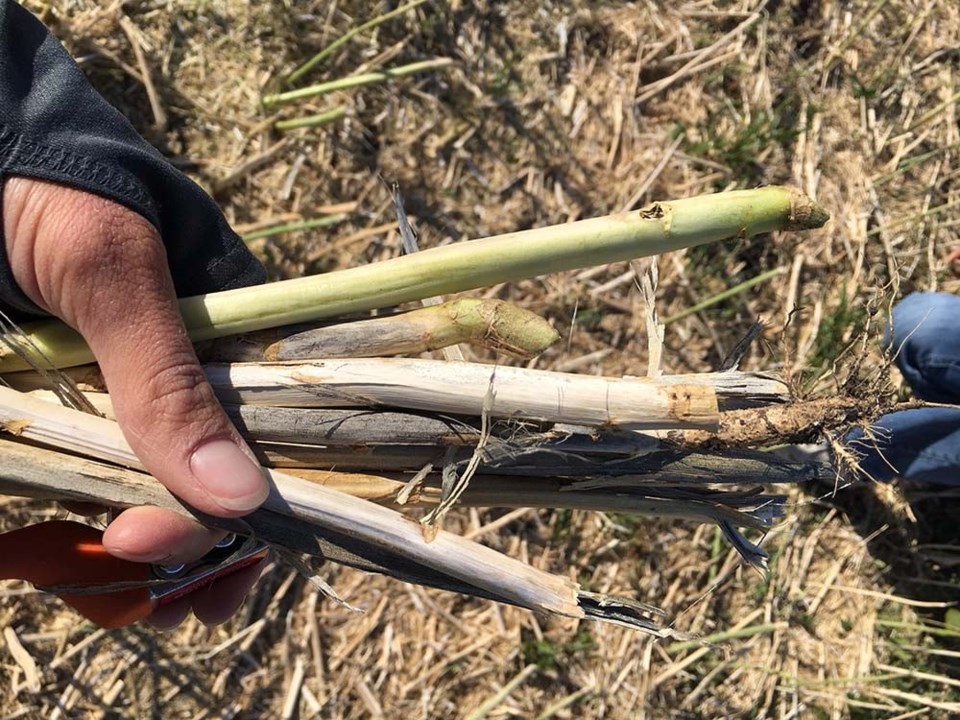CARMAN, Man. — Research in Manitoba has found some canola varieties, or canola lines in the development pipeline, have resistance to verticillium.
That’s a relief for canola growers because verticillium stripe has become a common disease in canola fields, at least in the eastern Prairies.
“I don’t know if they’re commercial (varieties) or not. The companies do not share that information with me,” said Dilantha Fernando, a University of Manitoba plant pathologist, who has been leading a project to understand genetic resistance to the soil-borne disease.
“They could be in the pipeline. They could be elite material. That part I don’t know. (But) this is good news for the (canola) industry.”
Verticillium stripe was discovered in Canada at a field near Winnipeg in 2014.
The fungus responsible for the disease, Verticillium longisporum, infects canola and produces tiny, pepper-like sclerotia on or inside the stem of the plant.
The fungal infection interferes with the uptake of water and nutrients in the plant. Symptoms include early ripening, plant stunting and leaf chlorosis, or yellowing of the leaf tissue. The
The sclerotia fall onto the soil and remain in the plant stubble after the canola is harvested.
“There are literally thousands of them in each stem that is infected,” said David Kaminski, a field crop pathologist with Manitoba Agriculture. “They’re like the size of a head of a pin.”
The small size helps transport the disease. Wind and water can carry infected soil and crop residue from field to field.
Since the discovery in 2014, verticillium has spread to canola fields across Western Canada.
Last year, it was found in 40 percent of fields in Manitoba and it’s now common in eastern Saskatchewan.
Alireza Akhavan, provincial plant disease specialist in Saskatchewan, led a verticillium survey in the eastern part of the province last year.
“We got shocked because we only looked at 25 fields and 16 of those had verticillium, so 60 percent of those fields in that targeted survey,” he said.
Given the high incidence of the disease, Akhavan and his colleagues are expanding the survey this year.
“We are going to cover the whole province after harvest and we’ll at least look at 100 fields for verticillium stripe to see what is the risk.”
Finding resistance to the disease is important because verticillium can cut into yields. In Europe, where it’s been around for decades, yield losses can be 10 to 15 percent or higher, depending on severity.
With resistance or moderate resistance in commercial hybrids or in development stages, researchers like Fernando are not starting from scratch to fight the disease.
In late July, Fernando shared some the results from the research into verticillium during a University of Manitoba plant science field day in Carman.
He and his team planted canola hybrids at research sites in Portage la Prairie and Glenlea, south of Winnipeg. Those research sites have soil that is infected with verticillium.
“The results in both locations are fairly similar. We can (be) assured that some of these (canola) varieties do carry resistance to verticillium,” Fernando said.
“There is a spectrum. There is highly susceptible, moderately susceptible, moderately resistant and resistant.”
Again, Fernando doesn’t know which canola hybrids have resistance to the disease because crop science firms haven’t shared the names and other details about the varieties with the researchers.
But if a company starts promoting one of its hybrids as resistant, western Canadian farmers will know soon enough, Fernando said.



